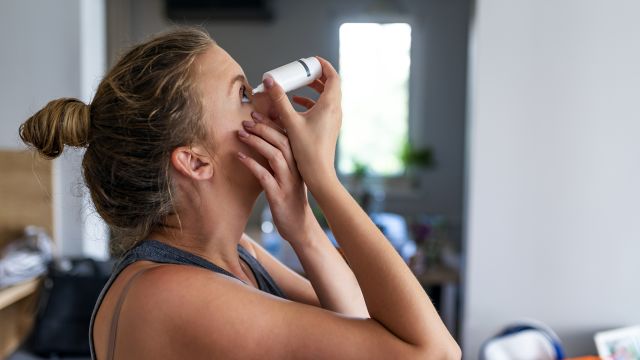Thyroid eye disease (TED) is a condition that affects people who have hyperthyroidism. When a person has hyperthyroidism, the thyroid gland located in the throat produces excess levels of thyroid hormones. These hormones are important to the normal functioning of the body’s organs and systems, but in excess amounts, they are damaging to the body.
TED occurs when excess levels of hormones cause inflammation and damage to the tissues around the eyes. People who have TED may experience a number of symptoms, including protruding eyes and eyelids that retract, eye “bags” (pockets of fatty tissue under the eyes), double vision, dry eyes, and redness and inflammation around the eyes. As a result of dry eyes, they may experience irritation, blurred vision, sensitivity to light, and damage to the structures in the eye.
The disease can cause permanent damage to the eye, permanent changes to vision, and in some cases, it can lead to blindness. Both TED and the underlying thyroid disease require treatment. If possible, people with TED should work with a multidisciplinary healthcare team that includes HCPs that specialize in both thyroid disease and TED, as well as other aspects of managing the condition.
Here, we look at what people with TED can expect from treatment.
Inflammatory phase
TED occurs in two phases and treatment will depend on what phase a person is experiencing.
The first phase is called the active phase or inflammatory phase. During this phase, inflammation is actively occurring in and around the eyes. This phase can last anywhere from six months to three years.
Treatment during this first phase focuses on relieving symptoms and reducing inflammation. The exact treatment prescribed will depend on a person’s symptoms and the severity of those symptoms. A treatment plan may include:
- Liquid teardrops to keep the eyes lubricated and reduce symptoms caused by dry eye, like irritation and burning.
- Topical steroids to reduce inflammation.
- Vitamins, including supplementation with selenium.
- Protecting the eyes by wearing wraparound sunglasses, avoiding things that can irritate the eyes (for example, a car’s heat or AC blowing directly at the eyes).
- Medications to reduce inflammation, such as corticosteroids or biologic therapies. Radiation therapy has also been used.
- Eyeglasses to correct double vision.
- Coverings to protect the eyes at night if the eyes won’t fully close. Your healthcare provider can show you how to make this dressing.
- Medications or simple in-office procedures that prevent the eyes natural tears from draining away, allowing them to properly lubricate the eye.
- Steps to reduce fluid buildup, such as sleeping with the head elevated and reducing salt in the diet.
- Lifestyle changes, such as changes to diet, exercise, and quitting smoking or avoiding smokey environments.
Healthcare providers typically avoid surgery during the active phase, as inflammation may still be causing changes to the structures around the eyes. However, surgery may be used if symptoms are very severe or are threatening the health of the eye.
Stable phase
The second phase is called the stable phase. Here, the inflammation is no longer active, but the changes to the appearance and function of the eyes and eyelids remain. The treatment for this phase is often surgery to restore the normal function and appearance of the eyes.
In January 2020, the first drug indicated for the treatment of TED was approved by the FDA.






